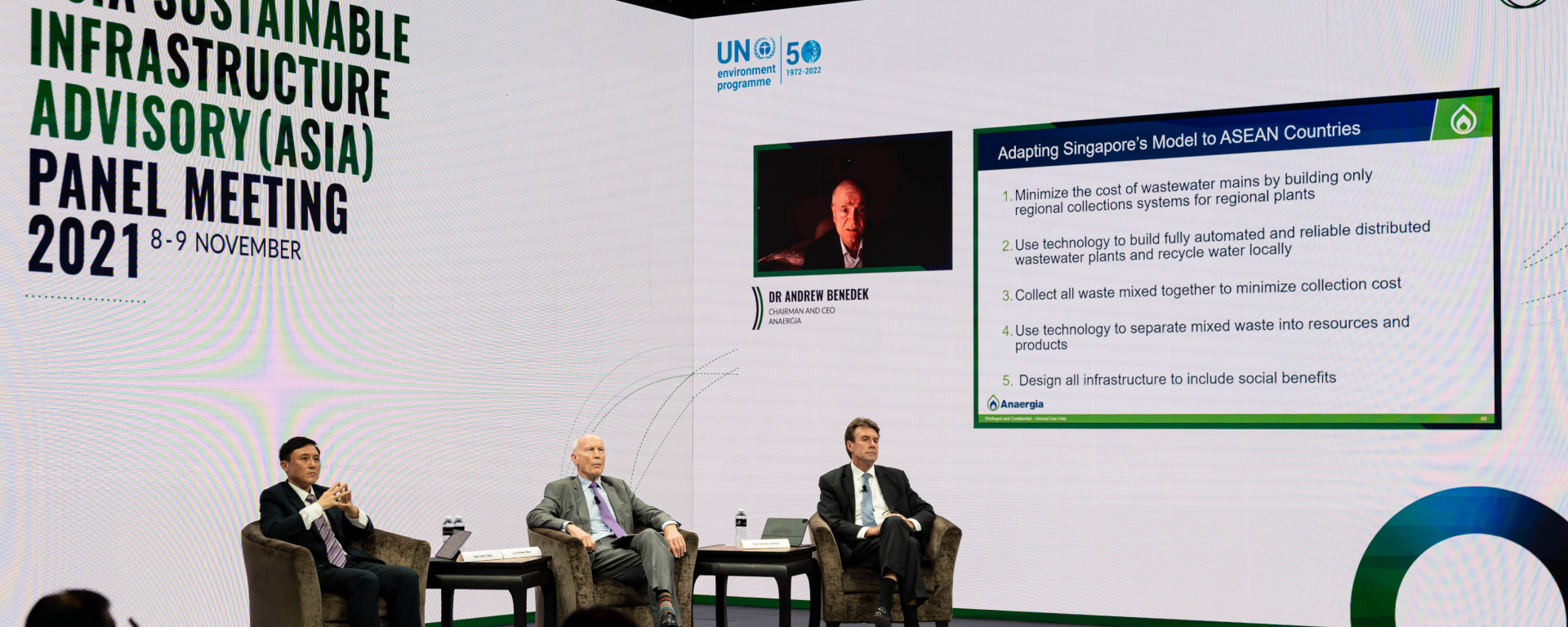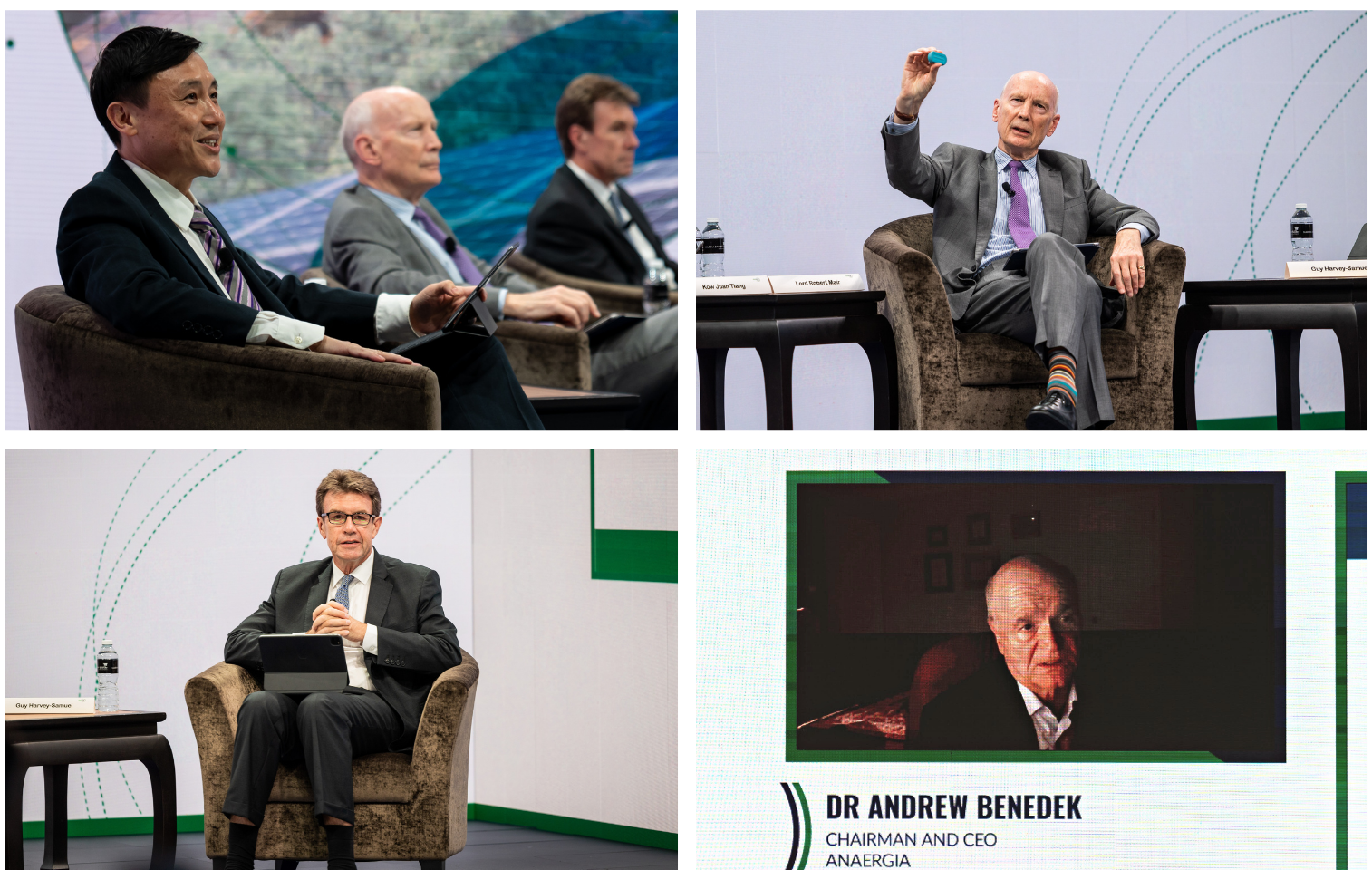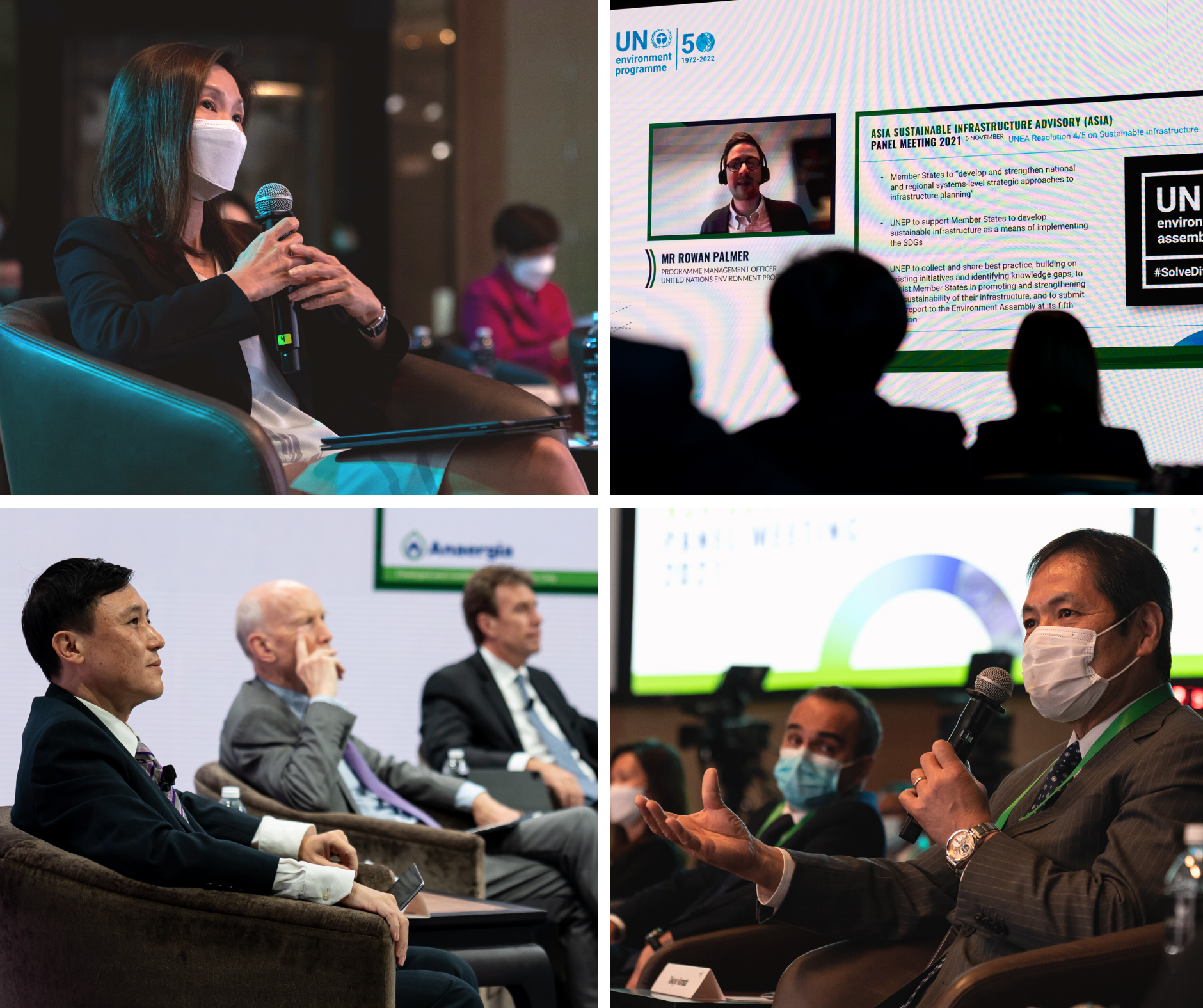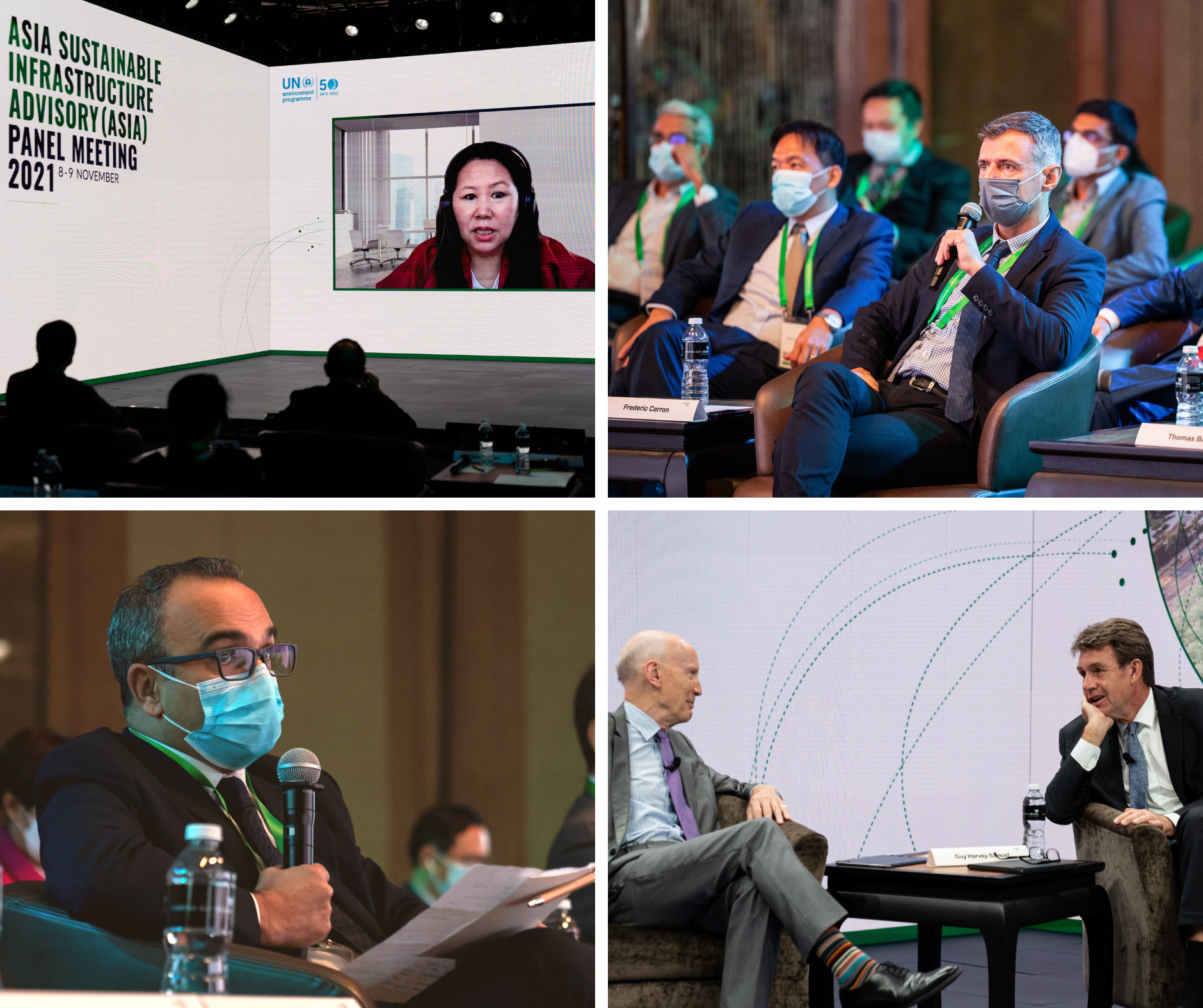ASIA Panel Discussion - Technology in Infrastructure
At the inaugural meeting of the Asia Sustainable Infrastructure Advisory (ASIA) Panel on 8 and 9 November 2021, Technology in Infrastructure was one of the three key themes discussed. The ASIA Panel members and invited industry leaders shared their insights on technological solutions for a more sustainable future.
Climate change poses an increasingly severe burden on cities. By 2030, rising sea levels may lead to losses of US$724 billion in Asia’s largest cities1. Hence, safeguarding the climate resilience of cities is key for continued economic and social development. Against this outlook, Infrastructure Asia and United Nations Environment Programme (“UNEP”) co-organised a discussion on Technology in Infrastructure. This was one of three public discussions organised as part of the inaugural meeting of the Asia Sustainable Infrastructure Advisory (ASIA) Panel. Below are some of the insights.
Clockwise: Moderator Kow Juan Tiang and ASIA Panel Members Lord Robert Mair, Dr Andrew Benedek, and Guy Harvey-Samuel
Incorporating Resilience Across the Entire Infrastructure Life Cycle
Harnessing technology can pave the way for countries to meet their climate goals and achieve carbon neutrality. Minister Indranee Rajah, Minister in the Prime Minister’s Office and Second Minister for Finance and National Development, highlighted that there are clear benefits of technology-enabled infrastructure in delivering better resilience and sustainability. As such, climate-proofing infrastructure against extreme weather events and reducing cities’ carbon footprints ought to be key priorities.
Crucially, technology can be leveraged across the entire infrastructure life cycle, from design and construction to operation and maintenance. Various industry leaders advocated the use of sensors, big data and artificial intelligence to generate data-driven insights and drive data-informed decision-making. This can in turn lead to reduced carbon, increased resilience, and more efficient prioritisation of resources. According to Lord Robert Mair, Emeritus Professor of Civil Engineering, Cambridge University, “once you understand how your infrastructure is performing, you can make rational decisions and strategies for whole life maintenance and asset management for more sustainable infrastructure.”
Drawing on an example raised by Lord Mair, small-sized digital sensors embedded in bridges enable engineers to collect and analyse data in real-time to identify anomalies in data patterns. Thereafter, asset managers can be alerted of structural changes in a timely manner. Such data collected with sensing technologies enables infrastructure planners to improve the design and resilience of infrastructure assets. Echoing this view, Eugene Seah, Managing Director of Surbana Technologies, commented that “IoT sensors are the way forward to monitor infrastructure and sustainability.” Notably, he highlighted the need for analytic platforms that can integrate building data and enable data-driven building maintenance to become commonplace.
Guy Harvey-Samuel, Chairman of Capella Hotel Group and Independent Director of Surbana Jurong, rightfully noted that “there is no single magic solution when it comes to reducing our energy consumption.” He advocated the use of passive design in buildings, such as utilising natural light, shade, and breeze to reduce mechanical cooling, heating, ventilation and lighting needs. For example, the National University of Singapore SDE4 building and the Port of Singapore Authority Livable City building incorporate passive design principles, including double external facades and large overhanging roofs, to achieve energy efficiency goals without sacrificing the occupants’ comfort.
Infrastructure planners ought to be attuned to the interconnectedness of natural and built systems, to promote the adoption of needs-based and integrated approaches to delivering sustainable infrastructure. Rowan Palmer, Programme Management Officer, United Nations Environment Programme, highlighted that “the newest or the latest technology isn’t always the best. We should consider what is the most effective and appropriate technology to meet the service needs in a sustainable and reliable way.”
Adopting Sustainable and Efficient Energy Infrastructure Solutions
Energy is the backbone of all infrastructure. Renewable energy is revolutionising the way that our cities function, and the potential to store electricity generated by the sun or wind is increasingly being leveraged to build resilience and reduce inefficiencies across the infrastructure value chain.
That said, the discussants urged caution about issues surrounding the renewable energy sector. Frederic Carron, Vice President, Middle East and Asia, Energy Business, Wärtsilä emphasised that renewable energy is intermittent by nature. As such, its use should be balanced with more traditional energy sources. In the same light, Thomas Baudlot, CEO Energy Solutions (APAC) and Country Head (Southeast Asia) of ENGIE recommended developing efficient solutions to address the intermittency of renewable energy sources.
Seth Tan, former Executive Director of Infrastructure Asia, reinforced that numerous communities across Southeast Asia continue to depend on unreliable power sources such as diesel generators, which have high carbon footprints. Looking ahead, microgrids could be viable alternatives for storing and distributing renewable energy in remote communities.
Invited discussants at the Technology in Infrastructure public discussion, organised as part of the ASIA Panel meeting
Enhancing the Resilience and Sustainability of Water and Waste Infrastructure
Globally, the climate crisis and COVID-19 pandemic have amplified the urgency of ensuring that essential services, such as clean water supply and waste management, are delivered reliably. Asia is no exception. Today, 300 million people across Asia do not have access to clean water, and 1.5 billion people lack basic sanitation services2. In order to reduce compounding existing hygiene and environmental challenges, governments ought to prioritise improving water supplies and waste management facilities.
Takuya Kamata, Director for Singapore, World Bank, identified reducing water leakages and improving water security as critical issues to prioritise. Takuya highlighted that more preventive measures can be taken to minimise the occurrence of water leakages. For example, digital technologies – including remote sensors to collect data and monitor water pipelines in real-time – can be adopted to identify any potential leaks. Furthermore, machine learning and big data are increasingly utilised by water agencies to protect important watersheds, with the aim of improving water security.
Bridging the Sustainability Gap with a Water-Waste-Energy Nexus Approach
Emerging markets across Asia are increasingly tapping on the water-waste-energy nexus, which seeks to maximise synergies amongst the water, waste, and energy sectors. In particular, governments appear eager to leverage on waste-to-energy (WTE) technologies to convert non-recyclable waste into useable forms of energy. This could be an important bridge for the next generation of waste management in Asia.
For countries with similar waste compositions as Singapore, Singapore’s tried-and-tested waste management experiences may provide a proof-of-concept for the bankability of WTE technologies. Singapore’s Jurong Island is a renowned example of a systematic solution to boost the circular economy and reduce the city’s carbon footprint. Koh Chiap Khiong, Chief Executive Officer (Singapore & Southeast Asia) of Sembcorp Industries, highlighted that Jurong Island houses centralised waste management systems and cogeneration power plants, which feed into a “a systems-level thinking and integrated approach in building infrastructure” on the island.
Cindy Lim, Chief Executive Officer of Keppel Infrastructure, reinforced that such whole-of-ecosystem collaboration – including sharing best practices across borders – is instrumental for new energy, water and waste technologies to be scaled.
Invited discussants at the Technology in Infrastructure public discussion, organised as part of the ASIA Panel meeting
Global and Local Partnerships to Drive Sustainable Technology Transfer
Traditionally, the implementation of new technologies has been subject to a top-down decision-making process. However, the discussants advocated a shift towards a bottom-up approach that embraces the local community’s involvement. Dr Andrew Benedek, Chairman and CEO of Anaergia Inc, emphasised involving the community when planning for new infrastructure projects, in order to maximise and effectively capture the social benefits of the project. Farchad Kaviani, Managing Director of Southeast Asia Municipal Water, SUEZ, concurred that citizens are equipped with better access to information, owing to the fact that “technology has made the invisible, visible”. In response, governments should strive to improve the transparency of decision-making processes.
There is no denying that both global and local partnerships are essential to catalyse the implementation of technology in infrastructure, and lay the foundation for a more sustainable, resilient and inclusive future.
1Greenpeace East Asia, “Sea Level Rise Poses Economic Threat to Asia Coastal Cities” | Link
2Asian Development Bank, “Meeting Asia’s Infrastructure Needs” | Link
This article is written by Lavan Thiru and Shaila Narendran, Infrastructure Asia. Special thanks to insights shared by:
- Dechen Tsering, Director, Asia and the Pacific Office, United Nations Environment Programme
- Rowan Palmer, Programme Management Officer, United Nations Environment Programme
- Dr Andrew Benedek, Chairman and CEO of Anaergia Inc
- Lord Robert Mair, Emeritus Sir Kirby Laing Professor of Civil Engineering, Cambridge University
- Guy Harvey-Samuel, Chairman of Capella Hotel Group and Independent Director of Surbana Jurong
- Cindy Lim, Chief Executive Officer, Keppel Infrastructure
- Eugene Seah Managing Director, Surbana Technologies, Surbana Jurong
- Farchad Kaviani, Managing Director, Southeast Asia Municipal Water, SUEZ
- Frederic Carron, Vice President, Middle East and Asia, Energy Business, Wärtsilä
- Koh Chiap Khiong, Chief Executive Officer, Singapore and Southeast Asia, Sembcorp Industries
- Manish Pant, Zone President, East Asia and Japan, Schneider Electric.
- Peter Head, Chairman, Resilience Brokers
- Takuya Kamata, Director for Singapore, World Bank
- Thomas Baudlot, CEO Energy Solutions (APAC) and Country Head (Southeast Asia), ENGIE




